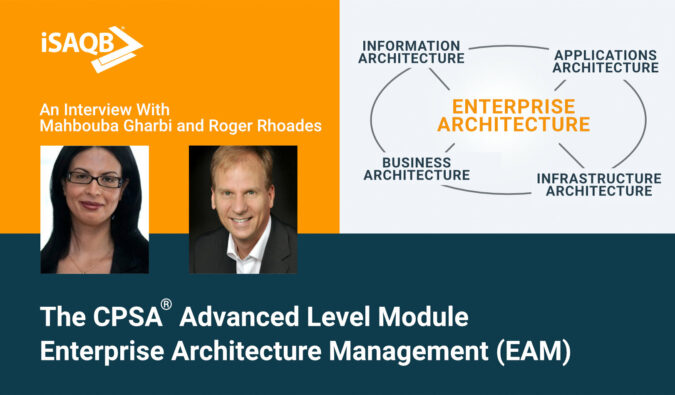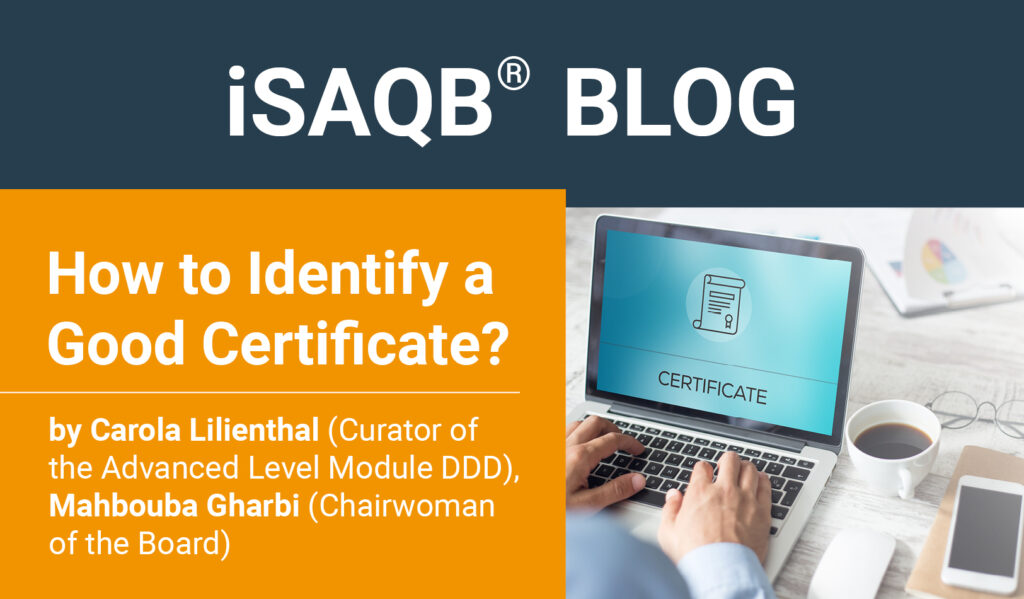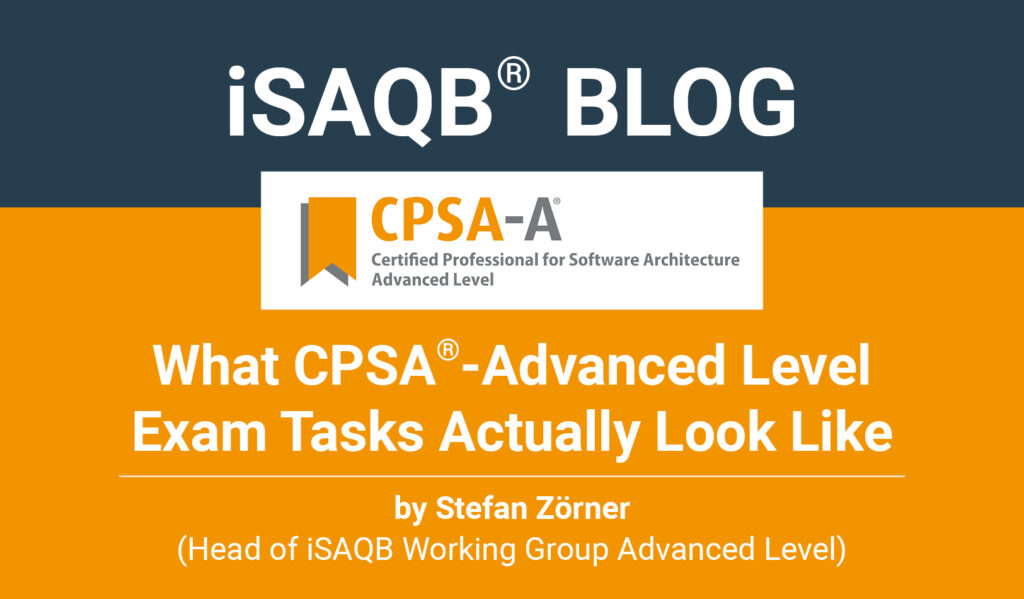About the CPSA®- Advanced Level Module Enterprise Architecture Management (EAM)
An Interview With iSAQB Members Mahbouba Gharbi and Roger Rhoades
The iSAQB editorial team asked several questions about the CPSA®-Advanced Level Module Enterprise Architecture Management (EAM) to Mahbouba Gharbi and Roger Rhoades. Both software architecture experts are long-standing iSAQB members and are, among other things, responsible for the maintenance and further development of the EAM module as curator (Roger Rhoades) and as co-curator (Mahbouba Gharbi).
What is Enterprise Architecture Management (EAM)?
One of the challenges with Enterprise Architecture Management (EAM) is that there are so many different definitions, each of which have differences and similarities. Therefore, one of the goals of iSAQB is to provide a standardized curriculum with a common vocabulary that brings uniformity to this topic.
It is important to differentiate between Enterprise Architecture and Enterprise Architecture Management. The definitions provided below originate from the Open Group, an industry-leading organization that provides a framework for conducting EAM.
“[Enterprise Architecture] is a conceptual blueprint that defines the structure and operation of an organization. It structures and gives context to enterprise activities delivering concrete business outcomes primarily, but not exclusively, in the IT domain.”
“[Enterprise Architecture Management] is a coherent whole of principles, methods, and models that are used in the design and realization of an enterprise’s organizational structure, business processes, information systems, and infrastructure.”
The “conceptual blueprint” of Enterprise Architecture is typically composed of multiple so-called “architecture domains” that define the structure and interaction of different architectural elements:
- Business Architecture: e.g., governance, organization structure and locations, business functions, and business processes.
- Information Architecture: e.g., logical and physical data assets, data governance.
- Applications Architecture: e.g., IT applications and interfaces that provide business functions.
- Infrastructure Architecture: e.g., platform services and technology components required to support the deployment of business, data, and application services, including middleware, networks, etc.
By designing a solution that includes all relevant aspects of the different architecture domains, Enterprise Architects create a holistic solution that ensures a successful implementation of the business strategy. The result is streamlined business processes with corresponding data, an optimized application landscape, and a modern, future-proof IT infrastructure.
What is the difference between Enterprise Architecture Management (EAM) and Software Architecture Management (SAM)?
The difference between EAM and SAM is primarily based on the scope of the architecture activities. Simply put, Software Architecture defines the architecture of a single IT application, while Enterprise Architecture defines the architecture of the entire enterprise.
Both EAM and SAM contain elements of all the architecture domains; however, SAM manages processes, data, application components, and technology and infrastructure components that are limited to a single IT application; whereas EAM could manage dozens, or even hundreds, of processes, IT applications, organizational units, technologies, etc. used within the entire enterprise.
Software Architects have been traditionally responsible for designing individual IT applications and Enterprise Architects for the integration of those applications. Enterprise Architects are also concerned with ensuring that the applications are well integrated with the corresponding business processes and operational requirements.
The demarcation between EAM and SAM is becoming less clear as organizations are moving to new approaches such as Domain-Driven Design (DDD) and Microservices. As IT applications become smaller and integration becomes an increasing concern, it is becoming more difficult to assign the architecture management activities to specific roles. This recent development requires a closer cooperation between architecture management roles.
What are the tasks of EAM in an enterprise?
The primary activity of the Enterprise Architect is to define a target architecture and roadmap that will achieve the business goals and strategy. Depending on the business problem or strategy, the activities could include everything from reducing IT costs to creating enterprise-wide implementation solutions, including business processes that cross business units or geographic locations, data flows and IT applications that impact several business areas, enterprise-wide infrastructure and technology solutions, etc.
Since the scope of EAM includes all architecture domains, the role of the Enterprise Architect becomes primarily a coordination activity. The Enterprise Architect typically coordinates with other stakeholders to define the architecture solution (e.g., Process Manager to define business processes, Software Architect to define IT applications).
Enterprise and Software Architects perform many of the same activities, just at a different scope, e.g., specify the target architecture, assess possible solution alternatives, perform compliance assessments, define architecture standards, perform compliance reviews, etc.
The Enterprise Architect may also perform additional activities such as:
- Clarify the business drivers, needs, goals, strategy, and constraints.
- Analyze market and technology trends.
- Support (or define) the development of the IT Strategy.
- Perform a stakeholder analysis.
- Define enterprise architecture principles, policies, guidelines, sample deliverables, reference architectures, best practices, etc. to guide and govern the architecture and implementation.
- Analyze and manage the business process, IT, and technology portfolios as a basis for improvements and governance.
- Assess the maturity of all architectural domains.
- Define the enterprise architecture vision and strategy.
- Define integration and migration strategies.
- Prioritize and consolidate the planned activities into an enterprise-wide architecture roadmap.
- Assess implementation readiness.
- Define the business case for the implementation of the target architecture.
Why has iSAQB defined “EAM” as an Advanced Module? What are the benefits of attending an iSAQB EAM training for an enterprise or Software Architect?
The course was designed to provide Software Architects with a broader understanding of Architecture Management so that they can provide better solutions that take into account aspects of more encompassing, enterprise-wide solutions. In doing so, they increase the chances of a successful implementation and ensure the achievement of the business goals.
There are several reasons why attending the iSAQB EAM Advanced Module is beneficial:
1. For Software Architects that simply want to broaden their horizons and understand the “big picture” beyond Software Architecture.
2. For Enterprise and Software Architects that want to understand how a concrete architecture solution is derived from the business goals and strategy as well as what is necessary to ensure its successful implementation.
3. For Software Architects that have successfully implemented large IT or general implementation solutions and are interested in evolving their career to the next level of Enterprise Architecture Management.
4. For attendees that want to understand the different architecture management roles and how the activities are coordinated between those roles.
5. Enterprise architects understand each layer of the enterprise architecture and are able to perform an end-to-end transformation using enterprise architecture frameworks such as the Zachmann Framework or The Open Group Architecture Framework (TOGAF).
6. Acquiring the knowledge for a complex task like Enterprise Architecture Management (EAM) is time consuming. iSAQB’s three-day EAM training provides the essential knowledge of this topic.
What is the development of the curriculum like? When will there be a new version?
The iSAQB EAM curriculum has recently undergone a major revision that is planned to be released by the end of 2023.
The revised curriculum is much more focused on the EAM topics that impact Software Architecture or EAM topics that are impacted by Software Architecture. For example, implementing a Microservices approach may seem like an IT-specific topic; however, this approach could impact enterprise-wide processes, data management, and infrastructure components. As another example, a seemingly small change at the business level could have wide-ranging impacts on many IT applications. The new iSAQB EAM curriculum was revised to address exactly these types of issues.
For which target group does the iSAQB recommend participation in the training? For which companies is EAM useful?
The course is focused on Software, Solution, and Enterprise Architects; however other roles are also welcome, e.g., Business Architects, Project Managers. It is a misconception that EAM is only applicable to large corporations. The methods learned in this course can be just as easily applied to small- and medium-sized companies.
Which prerequisites do I have to meet if I want to attend the training?
It is recommended that attendees have experience in implementing large IT or business solutions.
Share this article:
Related Posts
Featured in this article




